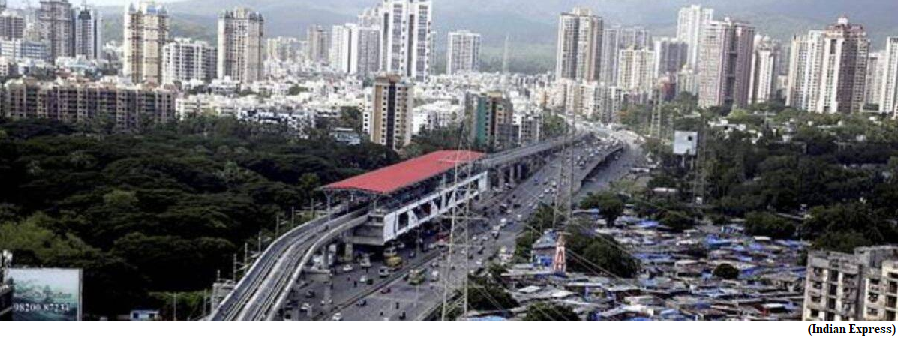The starved city (GS Paper 2, Polity and Constitution)

Context:
- The health of municipal finances in India is in jeopardy, with revenue losses after GST implementation and the pandemic adding on.
Scenario at all India level:
- As per the RBI, in FY21, at least 141 municipal corporations saw a sharp decline in revenue or a significant increase in expenditure of over 75 per cent, while being exposed to a revenue shortfall greater than 25 per cent. All this led to cuts in essential services, for example, sewerage services were affected by 55-71 per cent in most cases.
- Meanwhile, on the revenue side, there was a decline in projected growth in property tax of approximately 11 per cent, and municipal fees of 50 per cent.
- All this led to delayed salary and pension disbursements, and the general upkeep of such cities (for sanitation, road maintenance and water quality) declined.
Case of Delhi:
- Around 18,000 teachers working in about a thousand primary schools under the Municipal Corporation of Delhi are yet to receive their salary for the past two to four months.
- Pensions, too, have been delayed for retired teachers, along with salaries for other municipal workers, with salary/pension backlog reaching over Rs 90 crore in early January 2023.
- Every month, the corporation has to scrounge around to arrange Rs 774 crore to pay municipal workers and keep the city running, allocations for infrastructure development have consequently been constrained.
- Ironically, the unification of Delhi’s erstwhile three municipal corporations was conducted to overcome a regular funding crunch.
Case of Bengaluru:
- In Bengaluru, the Bruhat Bengaluru Mahanagara Palike (BBMP) has struggled to raise revenue, over 70,000 citizens are estimated to have underpaid their property taxes since 2016-17 leading to a loss of close to Rs 240 crore over the past five years.
- The city is caught in a vicious cycle of low municipal revenue.
Case of Chandigarh:
- In 2018, Chandigarh was noted to have Rs 492 crore of liabilities (composed of items like salaries, utility bills, and pensions) while seeing earnings of just Rs 171 crore.
- Consequently, development work had stalled until revenue reforms (for example, hikes in water tariff) led to an improvement.
- Even now, the situation remains grim, with the municipal corporation noted to have a budget of Rs 1,725 crore, while having projected revenues of just Rs 616 crore.
Challenges:
- Studies by the Indian Institute for Human Settlements (2022) have highlighted that urban local bodies’ (ULBs) own revenue was only 47 per cent of their total revenue, with property tax accounting for approximately 29 per cent of it.
- Most ULBs were dependent on transfers from the Centre and state governments. The urban financing challenge is huge. A World Bank estimate suggests that India will need to invest approximately $840 billion in urban infrastructure over the next 15 years.
Multi-pronged strategy:
Timely disbursements:
- Many urban local bodies and municipal corporations need a fiscal stimulus. Disbursal of external grants from the state and Centre is a concern.
- In September 2020, the CAG’s performance audit on the implementation of the 74th Constitutional Amendment Act highlighted a saving of over Rs 5,000 crore due to non-disbursal of grants in Karnataka, with additional savings of over Rs 15,600 crore due to lower payments by way of “grants for local bodies”.
- The urban local bodies in Karnataka had delayed disbursements. This needs to change. States and the Centre must ensure that disbursements are made on time.
Additional funding:
- A revolving fund, which offers budgetary stabilisation measures, can be considered, along with the provision of an overdraft facility when revenues and fiscal transfers are delayed. Additionally, green bonds need to be pursued, along with a joint corpus fund, funded by the Centre and states.
- Property taxes also are fit for rationalization, property tax collection can be improved by updating existing databases, reassessing properties using digital tools and imposing taxes on non-compliers and defaulters.
- Concessions will need to be rationalised, with state and local bodies incentivised to move away from fiscally ruinous measures (for example, free water and electricity).
Innovative financing:
- Expenditure efficiency needs to be boosted by pushing for outsourcing (for example, garbage services) and exploring PPP models (hybrid annuity models), and participatory budgeting.
- The Centre can expand incentives given to states under interest-free capex loans to cover aspects of urban development like framing building bylaws, pushing for public transport and pursuing mixed housing schemes.
- Innovative financing mechanisms can be pursued, including having states and municipalities pursue asset monetisation, financing from carbon credit generation, etc.
Land value capture:
- Land value capture remains a strategy that has often been replicated in countries like China and Brazil and states such as Gujarat, Maharashtra and Haryana.
- Maharashtra seeks to implement land value capture in a range of forms, with municipalities charging property owners for a specific project, development permissions and premiums for rule relaxation.
- Gujarat offers an interesting example in land pooling systems, any increase in land value due to public investment or civic initiatives is taxed to unlock funding for additional infrastructure and service delivery-related spend.
Municipal bonds:
- Municipal bonds have recently achieved scale, with municipal corporations raising over Rs 6,250 crore since 2017.
- As noted by the RBI’s November 2022 report on municipal finances, SEBI should issue regulatory norms to enable the listing of municipal bonds on the stock market, allowing such securities to fund green infrastructure projects.
- Utilising pooled finance and aggregating funds across investors can enable municipal corporations to collectively raise funds from the market for multiple projects, Tamil Nadu’s municipalities have successfully explored this option.
Way Forward:
- Finally, Civic action will be required. There should be a push for user charges for public service delivery. For capex costs, levies like betterment fees, impact fees and tax increment financing should be explored. Unlocking smart cities will require rethinking urban financing.


